Oil, Acrylic and Latex Paints Comparison (Differences, Pros & Cons)
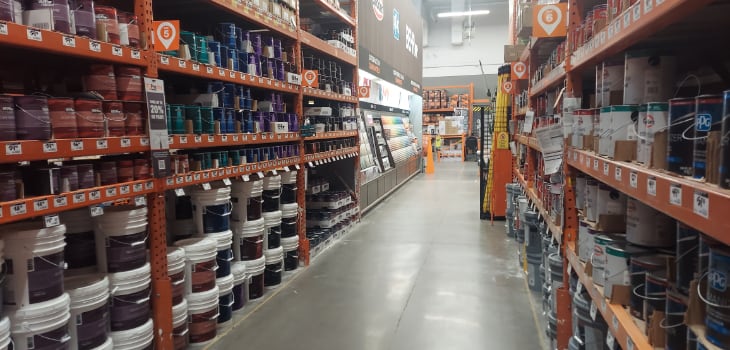
Paints are made for specific purposes for use on specific surface types and even different types of rooms. This can be confusing for property owners who are planning their painting project and want to find the right paint with the right finish. This often creates the “acrylic versus latex paint debate,” but what about oil paint – is it still an option for interior spaces?
Choosing the right paint for most people means choosing the right color, but it goes far deeper than that, as finish types are important, as are the ingredients in different types of paint. If you’re beginning your research, a paint comparison is definitely in order.
Knowing which paint will work for your project involves knowing about the composition of the paint, how it holds up to humidity or contact, the way light shines off of it and more. But to start, you need to know that paint is based on three different types – oil, acrylic and latex. There are pros and cons to each, which we’ll go over in the following sections.
Check out the following to figure out which is best for you:
- Why is it important to choose the right paint?
- Three different types of paints for interior and exterior projects
- Oil paints
- Acrylic paint
- Latex paint
- Acrylic latex paint
- Which type of paint is the best for your commercial painting project?
- The best quality paint brands for interior and exterior painting projects
- Hire a professional painting contractor in the Chicago area
Why is it important to choose the right paint?
Selecting the appropriate paint for your commercial painting project holds immense significance for several reasons. First and foremost, the right paint choice directly impacts the overall aesthetics of your commercial space, contributing to a welcoming and professional environment that resonates with your brand and clientele. Indeed, aesthetics are extremely important, but so too are various other aspects of paint, whether it’s oil paint, acrylic paint or latex paint.
Contractors want their work to last a long, long time, so they’re always thinking about the durability of the paint. They know which products hold up to Mother Nature, frequent cleaning and high-traffic areas where it is more likely to encounter wear and tear.
In addition, considering factors like indoor air quality, environmental impact, and safety concerns is pivotal when choosing paints for spaces frequented by employees and customers. While all wet paint will have some aroma to it, what you want to avoid is anything toxic that could be a health hazard, which is why oil paints are no longer an option for interiors in Illinois.
Three different types of paints for interior and exterior projects
Three categories of paints warrant thorough investigation when considering interior and exterior painting: oil, acrylic, and latex-based paints. Each type boasts its own set of merits and drawbacks, making them particularly suited for specific project contexts.
Acquiring an understanding of these distinctions can yield significant time savings, facilitate a seamless project execution, and enable you to dedicate your efforts to selecting the perfect color for your endeavor, free from paint-related concerns. The more you know about these three paints, the better equipped you will be to make a decision about what type of paint will go on your exterior and interior surfaces.
It wasn’t long ago that you could choose three types of wall paint for exterior and interior surfaces, but now Illinois residents must choose between two types of interior paints instead of three, as oil-based paint for interiors is no longer an option due to its volatile organic compounds (VOCs) that have been deemed unsafe for interiors.
1. Oil paints
Oil paints, commonly known as alkyd paints, are distinguished by their oil-based composition, offering rich pigmentation and a smooth finish. However, using them requires careful consideration due to their emission of strong fumes and potential toxicity, necessitating a well-ventilated workspace. Their extended drying time, while slower than latex or acrylic paints, is a boon for seamless color blending and is particularly beneficial for large surfaces or complex color applications. The durability of oil paints is offset by the difficulty in cleaning spills, making them a challenging choice in certain contexts.
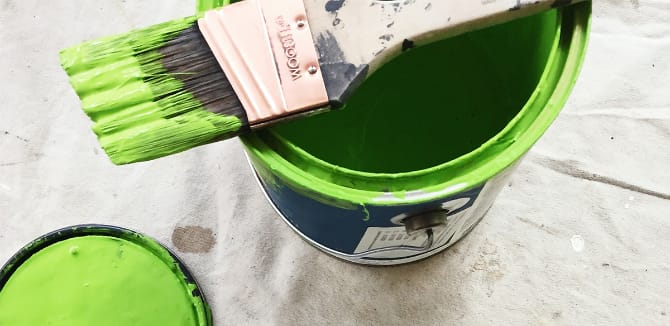
Oil paints are historically significant, but their environmental impact is increasingly a concern. They contain high levels of volatile organic compounds (VOCs) derived from fossil fuels, releasing toxic vapors into the air long after application. This aspect has prompted a shift towards more eco-friendly alternatives, especially as awareness of environmental issues grows.
Cost-wise, oil paints tend to be more expensive due to their extensive and pricier ingredients. They are designed to withstand harsh conditions and provide richer pigmentation compared to other types of paint. While oil paints have been popular for interior use, their fumes and long curing time pose challenges. In Illinois, for example, the use of oil-based interior paint is restricted.
Contractors working with oil paints must take precautions to minimize fume exposure, such as ventilating areas effectively or using protective gear. Despite these challenges, the durability of oil paint is a significant advantage. Once cured, it forms a sturdy film capable of withstanding frequent cleaning, making it suitable for high-traffic areas. The balance between the aesthetic qualities of oil paints and their practical and environmental considerations is crucial for informed decision-making in painting projects.
What is oil paint?
What is oil paint made of and why is/was it so popular? While “oil” paint is the common nomenclature for this type of paint, it’s actually made of alkyd, which is a group of synthetic polyester resins that originate from acids and alcohols. Alkyds are used in varnishes and adhesives as well as paint.
It's important to note that these paints can potentially be hazardous due to their toxicity and the emission of strong fumes when not properly ventilated. The toxicity of the fumes is what has motivated the health officials in many states to outlaw the use of oil paint in interiors.
Different features of oil-based paints
To answer the question, “what is oil paint?” – a good place to start is defining its characteristics. From its versatility (or lack thereof) to its ease of use and its durability, the following are descriptors of this once-popular interior paint, but painting with oil-based paint is still common for exterior work.
Versatility
You’ll need a thinning agent for oil paint, such as turpentine, as this product lacks water solubility. Also, one of the cons of using oil paint is that it doesn’t integrate with other material types.
Finish
If your surface has imperfections, the finish oil paint achieves will show all of them. Yet the glossy finish can be quite attractive on the right surface.
Durability
The reason so many contractors liked working with oil paint is that it looks great on clean surfaces, but also because it is highly durable, so it keeps the customer happy for a long time. When it does age, oil paint can oxidate, which leaves a tinge of yellow tint to the finish. However, due to its ability to withstand frequent impact, it’s often used in high-traffic areas.
Cleaning
While glossy finishes are easier to clean than matte finishes, oil paint when spilled is difficult to clean up. This product is not water soluble, which means it takes thinners and/or solvents to clean the paint off surfaces when spilled.
Scent
The distinctive odor that oil paint emits is part of its problem. It lingers for a long time in areas that are poorly ventilated. The smell is associated with volatile organic compounds, which are more commonly known by its acronym – VOCs.
Toxicity
Oil paint poses health risks, as the fumes are toxic when inhaled. Professional painters are highly cautious when using oil paints, ensuring that they are properly protected at all times.
What is oil-based paint used for?
Whether it is oil-based paint for wood, oil-based paint for metal or oil-based concrete paint, there are definitely many uses for this product. So when customers ask, “what is oil-based paint used for?” – the answer can be quite long.
First and foremost, it’s important to let customers know that oil paint for interior surfaces is no longer an option. Therefore, this product must be applied to exterior surfaces only. But even though oil-based paint is no longer allowed indoors, there remain many, many different types of exterior surfaces on which they can be applied.
One of the positive aspects of oil paint outdoors is that this is a durable product that stands up to various harsh environmental situations. From sweltering hot summer temperatures to bitter cold winters, oil paint endures it all.
Best uses for oil-based paint:
- Exterior painting projects
- Metal surfaces
- Wood surfaces
- Chalky surfaces
- Stained surfaces
Because of the concentration of VOCs in oil paint, it is considered a toxic substance capable of emitting harsh fumes that are dangerous when inhaled. Therefore, the State of Illinois has banned the use of oil-based paints on interior surfaces.
What are pros and cons of oil paint?
Due to their less environmentally friendly composition, oil-based paints have experienced a gradual decline in popularity. Even after making adjustments to the paint formulas, user satisfaction has not seen significant improvement. This has led to challenges in applying exterior oil-based paints, and some lighter shades may develop a yellowish tint relatively quickly.
In response to these concerns, several states, including Illinois, have implemented regulations or outright bans on the use of oil-based paints. This is primarily due to the presence of volatile organic compounds (VOCs) in the paint formulas, often used as solvents. VOCs are released into the air as the paint dries and can pose potential health risks to individuals. It's important to note, however, that certain products labeled as low-VOC or no-VOC exterior oil-based paints are now available, offering a potentially safer alternative.
Advantages of using oil paints
A hearty, rich and durable product, oil paint has a glossy finish that is treasured by those who are trying to achieve a specific aesthetic. The great look added to the fact that it can take a beating has made this paint extremely popular despite its high VOCs and relatively slow drying time.
The following are the main advantages of using oil paint:
- Long list of colors from which to choose
- Cans can be open longer without compromising the paint
- Hard and durable finish
- Durable, making it a great choice for high-traffic areas
- Spreads even and level
- Resists moisture
- Less likely to shrink when dry compared to other paints
- Effective coverage
Disadvantages of using oil paints
Painting with oil-based paint has a few major disadvantages, the most annoying of which is that when spilled, it’s difficult to clean up. Other paints are soluble, which makes spills almost a non-issue, but the disadvantage of oil paint is that it needs to be cut with a thinner, such as turpentine.
Over a length of time, the paint hardens and is therefore subject to splitting, especially if the underlying surface, such as wood, shrinks. Paint on external surfaces that have extensive exposure to ultraviolet light can be affected over time, resulting in a chalky and dull effect.
Here are the main disadvantages of using oil paint:
- High VOCs, making it a toxic product
- Banned for interior use in Illinois (and other states)
- Cleaning difficulties when spilled
- Heavy fume odors
- Older oil paint turns yellow
- Thicker in consistency, making it more difficult to work with
- Its durability decreases with age
While there is no shortage of cons in using oil paint, it remains quite popular for exterior painting work.
2. Acrylic paint
Acrylic paint is a water-based product that is extremely popular with DIYers and painting contractors. It is popular because acrylic is easy to work with. For example, spills and splatters are not a huge issue, because it’s a water-soluble product that can be wiped up. The history of acrylic paint goes back to the early 1930s when it was developed by German-based chemical company BASF.
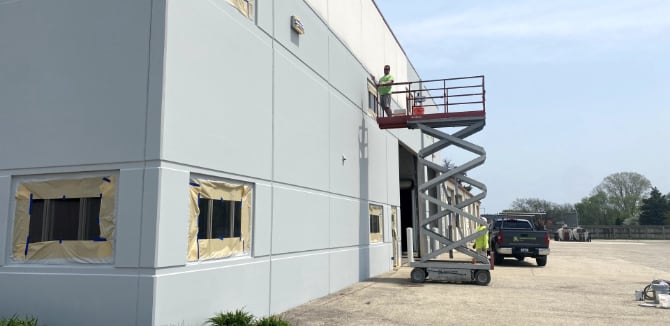
One of the characteristics of acrylic interior paint and acrylic exterior paint is the fast drying time. Another is its inability to cover oil paint, as the properties of acrylic paint do not allow it to adhere to such surfaces. Otherwise, it adheres quite well to a host of other surface types.
Part of its reputation for water resistance is related to its glossy finish, which is inherent with acrylic paints. This added durability makes it a go-to choice for exterior painting jobs. And while some acrylic products can be made with a high gloss finish, they can also be produced in lower gloss finishes.
What is acrylic paint?
One way to answer the question, “what is acrylic paint?” is to define its ingredients, which include an acrylic polymer emulsion, metal soaps, silicone oils, plasticizers, defoamers and stabilizers. Pigments of all colors can be suspended in these ingredients to create a range of options. It’s these ingredients that offer one of acrylic paint’s most attractive features – its ability to expand and contract without cracking. Furthermore, this paint is resistant to mold and mildew, which lends to its low-maintenance characteristic.
As a water-soluble product, cleaning up is easy when acrylic is wet, but it loses its water solubility once dry, which is why it is water resistant and able to withstand the elements. Whether it is acrylic outdoor paint or indoor paint, the drying time is rapid. For those wondering what acrylic paint is made of, it’s important to note that the polymer emulsion of water and binder is what adds to its fast drying time, but also its ability to adhere well to various textures.
What is acrylic-based paint used for?
Acrylic-based paints have such a wide variety of uses that it is no wonder how they’ve gained traction with so many painting contractors who rely on high-quality products to turn out high-quality work. Acrylic paint for vinyl siding is a popular option, as vinyl siding covers the majority of homes throughout the U.S. There’s even an acrylic paint for metal, offering excellent adherence qualities.
Another popular product is acrylic paint for wood, which can be used to offer protection, as well as cater to the aesthetic needs related to everything from porches to elongated decks, wood siding and fences and various wood outbuildings. Need your concrete painted? There’s also acrylic paint for concrete, whether it’s a concrete garage floor, walls, foundations or parking lots.
Acrylic paint is often used because of its low fume emission. For property owners who don’t want to endure prolonged exposure to the scent of new paint, acrylic is the paint they need for their interior projects. As you might have guessed, acrylic is also low in VOCs, making it a safe and eco-friendly product. And when the project needs to be completed quickly, acrylic paint’s ability to dry quite rapidly makes it an attractive choice.
Best uses for acrylic paint:
- Interior trim work
- Exterior projects
- Cabinetry
- Bathrooms
- Metal
- Drywall
- Plaster
- Stucco
- Covering rust
- All siding types
Professional painters know they can rely on acrylic paint, making it a go-to option for interior and exterior work. From stucco to metal, vinyl to concrete, acrylic is a good match for just about any surface, and it looks great and lasts a long time.
What are pros and cons of acrylic paint?
Are there considerations that will influence your decision to use a product other than acrylic paint? Yes, there are definitely some pros and cons of acrylic paint use. A pro to some might be its quick drying time, allowing for quicker completion of projects. A con that is often cited regarding acrylic paint is that it dries darker than it appears when wet.
While acrylic paint is known to cover just about any surface, which makes it a versatile paint for almost every project, anyone dealing with painting over oil paint will not be so attracted to acrylic paint, as it does not adhere well. Let’s cover all the pros and cons of acrylic paint here.
Advantages of using acrylic paints
Painting with acrylic paint certainly offers advantages that many contractors and DIYers can attest to. Paint suppliers are making high-quality acrylic paints today in so many colors that it’s nearly impossible not to find a hue that matches even the most discerning of tastes. It’s a product that can be used indoors as easily as outdoors and it’s eco-friendly. Resistance to harsh weather and easy cleanup are just a couple of advantages of using acrylic paint, but this list offers a more thorough examination of what users most often comment about acrylic:
Top advantages of using acrylic paint:
- Resistant to cracking and peeling
- Can be used on many surfaces
- Expands and contracts with heat
- No availability concerns
- Resistant to ultraviolet light
- Dries fast
- Adhesive properties are strong
- Resists fading
- Flexible and breathable
- Many color and finish options
- Appropriate for indoor and outdoor projects
- Holds up to extreme heat and cold
Disadvantages of using acrylic paints
Despite all the advantages, there are some disadvantages of acrylic paint that will need to be considered by potential users. For example, if your budget is tight, you might need to make allowances elsewhere, as this paint is more expensive than other types. There are also subtle tone differences when the paint dries, which is usually typified as becoming darker than it appears when wet. And while acrylic is easy to clean up when wet, you will need solvents to clean up areas where spills or splatters have dried.
Top disadvantages of using acrylic paint:
- Finishes are not as extensive as other paint types
- Expensive
- Color is darker when dry
- Dries fast, which limits time to work with it
- Can crack in high-traffic areas
- Sometimes difficult to clean when dry
- Moderate levels of VOCs
- Multiple coats required
- Could require chemical solvents
3. Latex paint
While acrylic is a water-soluble paint, latex paint is actually water based. It’s a highly user-friendly paint with many uses. Some would say it “revolutionized” home decorating because of its ease of use, but also because of its versatility. Whether it is latex interior paint or latex exterior paint, this product can be used on so many types of surfaces, which also makes it a highly popular choice for not only DIYers taking on home improvement projects, but also for experienced professional painters who need a paint they can rely on time and again.
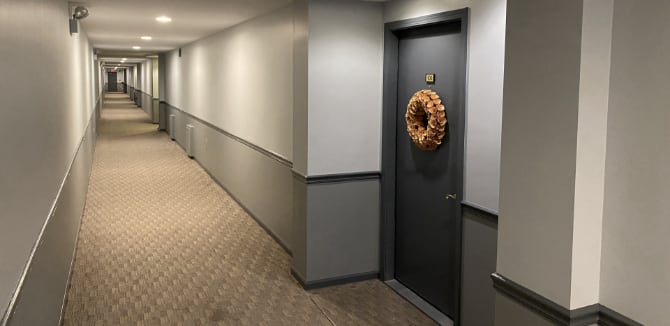
If you’re wondering what latex paint is good for, the answer is, “just about anything.” This paint is capable of covering expansive areas and is widely available, so there is never a problem gaining access to it. Furthermore, manufacturers produce it in so many colors that there is no worry about finding the right fit.
What is latex paint?
If you’re curious about what latex paint is made of, there is no need to brace yourself for a long list of chemical names, as this paint is simply acrylic resins, pigment and water. The resins include such compounds as vinyl acetate, propylene oxide, propylene glycol and titanium dioxide. While the addition of acrylic resins might prompt some to call it “acrylic” paint, just know that actual acrylic paints are chemicals based, whereas latex paint is water based.
Furthermore, describing what latex paint is also includes details about its low odor, which is due to its reduced concentration of VOCs. Rather than having the chemical additives that are included in other paints, which emit fumes, latex paint lacks these compounds and therefore offers less odor. While the low VOCs are a plus, the lack of them also takes away from the paint’s elasticity, which means it isn’t as durable as acrylic paint in terms of expanding and contracting.
What is latex-based paint used for?
Latex-based paint can be used for many different types of painting projects, interior and exterior. You’ll find this product in residential, industrial, as well as commercial settings. What is latex paint used for in terms of surfaces? It adheres to just about anything, including drywall, plaster, stucco and any type of siding. Therefore, you’ll see latex paint for metal, latex paint for wood and latex paint for concrete offered by a variety of quality paint vendors.
Best uses for latex paint:
- Wood surfaces
- Interior projects
- Aluminum siding
- Expansive projects
- Stucco walls
- Ceilings
- Plaster surfaces
- Drywall
- Concrete
There is no shortage of uses for latex paint, whether it’s interior or exterior. It’s used to cover old paint and in new construction. It is a versatile option that offers a lot of reliability, but there are also hundreds of colors from which to choose.
What are the pros and cons of latex paint?
Making the right decision involves staying clued in on the pros and cons of latex paint and other types you’re considering for your project. While there are advantages to using latex, such as low VOCs, durability and good coverage, there are also some undesirable factors to consider, including limitations in terms of durability.
Latex paints come in many colors and finishes, so there will be no problem finding the color and finish that meet your expectations for each of the rooms you’re painting, or even your exterior surfaces. Will weather play a factor into the durability aspects of the paint you want for an exterior surface and are you planning on painting metal of any type? The more you know about your project going in, the better informed your decision will be about your paint choice.
Advantages of using latex paints
There is such a long list of advantages of latex paint usage that it would seem to be the perfect paint for just about any project, especially if it is indoors. Why indoor painting projects? Because the toxicity level of latex paint is among the lowest, which means you won’t have to suffer through the odorous new paint situation to deal with like you do with other types of pain. But what about exterior work? The advantage with latex is that it prevents organic growth, such as mold or algae, from growing because it does a great job of sealing surfaces.
Top advantages of using latex paint:
- Crack resistant
- Water-based paint
- Doesn’t yellow with age
- Affordable
- Chalking resistant
- Widely available
- Doesn’t require chemical additives for use
- Resistant to mildew and mold
- Non-toxic
- Odorless
- Multiple finish options
- Few coats to fully cover surfaces
- Fast drying
- Excellent coverage
- Low VOCs
- Cleans easily with soap and water
Disadvantages of using latex paints
The disadvantages of latex paint must also be considered before making the decision to use this product. An important example is using latex on wood: if you’re not prepared to sand between coats of latex, consider another product because painting with latex paint on wood can cause swelling. Also, because latex dries so quickly, you must be extremely careful of leaving brush marks, as they will be more visible with latex than with other paints.
Most common disadvantages of using latex paint:
- Poor adhesion to metal
- Durability lacking for exterior surfaces
- Brush strokes can be apparent
- Doesn’t hold up to extreme temperatures
- Can chip/peel on wood surfaces
- Dries quickly in an open can
- Doesn’t breathe
- Stains easily
What’s the difference between oil, acrylic and latex paints?
It’s important to make a paints comparison before embarking on any project, as there is a time and place for each type of paint. For example, oil paint was once an option for interior projects in Illinois, but not anymore as they have been relegated to exterior projects. And oil paint really performs in exterior environments, as they are quite durable and holds up to extreme weather.
Water-based acrylic paint has grown in popularity with everyone from DIYers to painting contractors, as this paint offers rich colors and exceptional durability. Furthermore, acrylic paints are valued for their eco-friendly ingredients, making them less of an environmental concern.
Latex paint, which is water based, has some similarities to acrylic paint, but is considered even more eco-friendly, leaving behind only the most minimal odor when wet. It is durable enough to handle high-traffic interior spaces.
Latex vs. acrylic paint
Among the most obvious differences to account for in the latex vs. acrylic paint debate is the ingredient list: acrylic paint is more rooted in chemicals whereas latex paint is a true water-based paint. And while both are considered eco-friendly, acrylic will emit it slightly more fumes than latex paint.
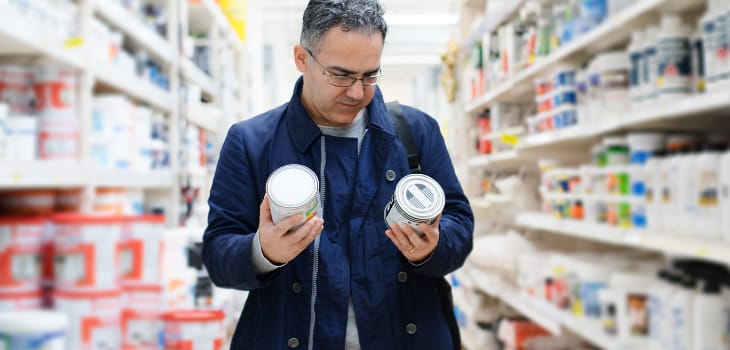
Another obvious difference is in the elasticity of the products. The chemicals used in acrylic paint allow for more elasticity than in water-based latex paint. This means acrylic will expand and contract with the surfaces upon which it is applied. Latex, on the other hand, will be more prone to peeling and cracking under such stress.
And what about interior and exterior preferences? Most experienced painting contractors doing outdoor work will opt for acrylic, mostly because it will perform better than latex, which includes resisting fading from the sun or succumbing to water damage. But for interior walls and ceilings, the easy-to-clean latex paint usually wins out.
Comparison of latex and acrylic paint:
What’s the difference between latex and acrylic paint?
All paint varieties have some noticeable differences. For example, the difference between latex and acrylic paint is the amount of chemicals in one over the other. When fewer chemical ingredients matter to you, you’ll choose latex.
But what is the difference between acrylic and latex paint in terms of cleanup? While acrylic has more chemicals, they are both water-based paint, which means they are each rather easy to clean, but when novices take control of the brush and need to make corrections, it’s easier with latex, as its lack of chemicals compared to acrylic makes for easier cleanup of minor errors.
As for acrylic vs. latex paint for interior walls, either is a strong candidate, but when lower fume emission and easier cleanup rank high on the list, latex wins.
Acrylic vs latex paint: side-by-side comparison:
Paints composition
Upon closer inspection in a side-by-side comparison of latex vs. acrylic, turn the focus to how the pigment, which is the coloring component of a paint, binds with other materials. In acrylic, the pigment attaches to an acrylic polymer emulsion, which is basically a chemical associated with plastics, thus the elasticity properties of acrylic paint. Latex pigment, however, binds with synthetic latex binders, which are not related to plastics and therefore not as elastic. Also, pigment is sometimes referred to as “bolder” in acrylic on account of the way the pigment disperses in the chemicals compared to latex.
Paints drying time
If your project requires multiple coats, you need to adjust for drying time between coats. That means if your project is on a tight schedule, choose acrylic paint, as it dries in about 15-20 minutes, which is faster than latex. Also, within about 24 hours, acrylic paint will reach complete hardness.
Latex paint takes up to two hours to dry, but depending on the consistency of which it was applied, could take a full day to dry enough to paint over with a second coat. Full hardness will take longer than a day, but also depends on various environmental factors, humidity and temperature being the most impactful.
Paints appearance
The reason acrylic and latex paints seem so interchangeable from one job to the next is because they have a similar appearance after application. Upon closer inspection, some might find the color of the acrylic paint to be more appealing. The ingredients of acrylic paint also make it a more durable product, which allows its appearance to hold up over time, which is important when it is applied on exterior surfaces subjected to the elements.
The ease at which latex paint is cleaned when spilled or when a brush stroke or roller goes astray, which is important for the overall appearance in interior work, makes it a popular choice for these projects. Latex, because of its appearance, is also a top choice for ceilings, which is another reason it’s a popular choice for interior work.
Paints durability
Various environmental factors have a great impact on the durability of paint, so no matter what it is made of, variables like sun, rain, snow, hail and others will influence the lifespan of paint on exteriors. Heat fluctuations and general wear and tear can also impact the durability of interior paint.
When you put acrylic and latex paint side-by-side, you have to consider who makes the paint – is it a company that uses quality ingredients and does research on their products to provide the most durable paint possible? Is the surface the paint is applied to properly prepped? Is the heat and humidity at proper levels for painting? Does the finish of the paint match its purpose? All these factors are hugely important to the durability of the paint.
Generally, it is known that acrylic paint is more elastic than latex, which means it can withstand more temperature fluctuations and won’t chip or peel as readily as latex will in similar environments.
While latex might win out for interior jobs because of its great look, ease of use and because it’s easy to clean, acrylic is the more durable product, making it more suitable for exterior surfaces.
Mold or mildew resistance of paints
Mold and mildew are big concerns that when allowed to proliferate. Latex and acrylic are each excellent mold- and mildew-resistant products, but in different ways. Latex acts as a barrier with its airtight qualities, thus not allowing oxygen, which is essential for mold and mildew growth, to get to the surface. Acrylic, however, is made with chemicals that effectively kill mold and mildew before it can become a problem.
Whether it’s an indoor area that is subjected to moisture on a frequent basis or exterior surfaces that take the brunt of humidity and precipitation, latex and acrylic are each able to keep organic growth from occurring. Not only does this mean less maintenance, it also means users get healthier, cleaner and more appealing living spaces.
Paint adhesion
Different paints have different adhesion qualities. With acrylic, you can apply it directly to metal surfaces without a metal primer. You can’t do that with latex and expect the same quality outcomes, as it will require a primer. In fact, most professional painters using latex will insist on priming almost all surfaces prior to applying latex. Furthermore, due to the ingredients in acrylic paint, it simply has stronger adhesion powers than latex, giving it the upper hand in this category.
Paint toxicity
We’ve come a long way since the days when lead was used in paint. And despite the fact that paint is far safer today, acrylic is still known to have more toxic elements in it than latex. This is because rather than being composed of many chemical binders like acrylic is, latex is a water-based paint that does not emit fumes like acrylic does.
Does this mean latex paint is 100 percent safe? Not quite. Latex contains titanium oxide and iron oxide, so when the paint is still wet, these chemical emissions can cause some health concerns when breathed in.
If you’re considering acrylic for your interior work, be sure to inquire about paints that have fewer toxic chemicals, as there are manufacturers making acrylic today that bypass some of the more harmful chemicals.
Paint elasticity
Elasticity matters because when the paint is applied and dries to a surface, it needs to be able to expand and contract as the surface does, and this movement is influenced by temperature and humidity fluctuations. Acrylic paint’s polymer emulsion compounds allow for this elasticity, whereas latex paint lacks it. There are elastic tendencies in latex, just not as expansive as those seen in acrylic. This is what makes acrylic resistant to peeling and cracking.
In areas subjected to extreme fluctuation of temperature and humidity and especially on surfaces that are known to contract (like wood), acrylic becomes the optimal choice.
Paint and shelf life
If you plan on having paint stored for 10 years, latex and acrylic will both still be usable. However, the shelf life of acrylic, which includes more preserving chemicals than latex, will last for around 15 years. The caveat is that these containers must be sealed.
Once the container is open the clock begins ticking on the time it has before it dries out. Acrylic, despite lasting longer in the unopened can than latex, will dry out faster than latex in a can that’s been opened. In any case, if you’ve got leftover paint and want to see a longer shelf life, tuck it away in a cool and dry environment.
Paint and areas of use
Is there a distinct advantage for the area in which a latex or acrylic paint will be used? Yes. Acrylic is the choice for exterior surfaces, whereas latex is often the most popular option for interior work. From canvas and ceilings to drywall and trim, latex is the product most professional painters use and recommend for interior surfaces.
But when the area of use is outside, acrylic is the product of choice. Whether it’s concrete, metal, wood or brick, exterior surfaces get excellent coverage with acrylic, which will adhere to these surfaces and offer great durability. Acrylic is typified by its durability and resilience against everything from harsh sunlight to pelting rain and anything in between.
Paints cost and availability
When the budget is tight, nothing is as friendly as latex paint, as it can be made at less expense and is widely available, which drives the costs down. Comparatively, acrylic, with all its costly chemical polymers, is going to hit the pocketbook a little harder. On the low end, you can get a gallon of latex paint for around $15 compared to a gallon of acrylic at $20. However, more premium quality paints will go upward of $60 per gallon for latex and $80 per gallon for acrylic.
When budgetary restrictions aren’t in play, seeking out the brand that has the best color and finish options is the path to success, and this counts for interior or exterior work involving latex or acrylic. Keep in mind that latex paints are usually the preference for those painting large areas, as latex is available in larger quantities and therefore offers some cost breaks.
Finally, when considering cost, you also have to factor in the durability of acrylic, which can outperform latex in harsh environments and will not require repainting as often as latex, which can save money in the long term.
Maintenance
Maintenance can include anything from cleaning off dirt and grime to putting hours of elbow grease into stubborn mold and mildew outbreaks. Fortunately, with acrylic and latex, each is great at restricting organic growth. But there is also the cleaning during the actual application of the paint that must be considered, as splatters and spills are common. Latex, being water based, is far easier to clean up than acrylic, and this includes cleaning out the brushes as much as it does cleaning up spills.
Once dried, the finish of the paint has a lot to do with maintenance, as glossy finishes are easier to clean than matte finishes. In areas where frequent scrubbing can be expected, such as high-traffic hallways, acrylic paint’s chemical additives allow it that extra bit of protection to hold up to cleaning after cleaning.
Paint lifespan
There are many factors that go into how long paint will last, but generally speaking, you can expect 5 to 10 years out of latex and acrylic paints. The factors include the quality of the paint, how it is applied, the quality of the surfaces it is applied to and the environmental factors influencing the integrity of that surface. For example, you can expect a lot more life out of paint on an interior wall that is rarely subjected to natural light or human activity than you can from paint on an exterior wall that bears the brunt of harsh weather. Given the ingredients of acrylic paint, this product has a far longer lifespan on exterior surfaces than latex does.
Paint and eco-friendliness
Volatile organic compounds (VOCs) are the enemy of the environment, which means paint that has low VOCs is considered “eco-friendly.” When putting the acrylic and latex paint side-by-side, the clear winner is the water-based latex paint. While it still has some toxic compounds in its list of ingredients, it emits far fewer toxic fumes than acrylic paint, which is made with more toxic chemicals. This makes latex a go-to option for indoor work.
4. Acrylic latex paint
When the decision between acrylic and latex becomes too difficult, why not choose both? Yes, that’s an option now with acrylic latex paint. This paint takes all the advantages of each type and combines them into one product, creating a paint of great quality. Essentially, this process takes latex paint and combines the acrylic resin, which allows the latex to get a substantial boost in adhesion abilities – an area where it lacks on its own compared to its acrylic counterpart.
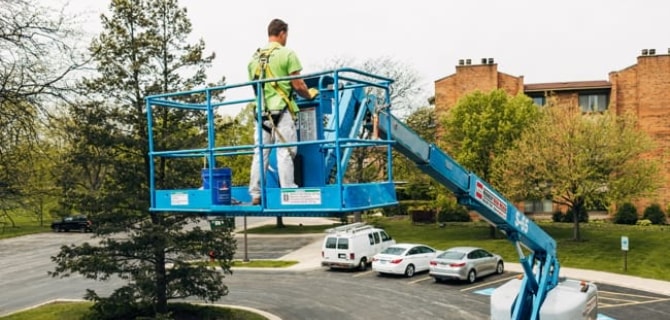
The unique adhesion qualities don’t sacrifice the appearance of the paint, as it retains its beautiful finish. But does the acrylic latex exterior paint protect against peeling and cracking like acrylic paint? The answer is yes. But what about metal and wood – can the acrylic latex exterior paint adhere to these surfaces? Again, the answer is yes. Simply put, the combination of each of these popular paint types brings the best of both worlds.
What is acrylic latex paint?
To answer the question, “what is acrylic latex paint?” – a good starting point is to describe its attributes. “Flexibility” definitely comes to mind first, as this hybrid paint can expand and contract with various temperature fluctuations and not peel or crack. And unlike acrylic paint on its own, the hybrid version does not yellow over time. Rather, it maintains its color integrity, even longer than oil-based paints. And unlike oil-based paints, which are no longer legally usable in indoor settings, acrylic latex paint doesn’t emit toxic fumes.
This paint has earned the attention of many, as it is versatile and capable of effective use in interior and exterior settings. Its easy application is attractive to those working on intricate indoor surfaces, but its durability is attractive to those embarking on exterior projects.
For anyone who would rather not work with solvents, as is necessary with some paints, latching onto the acrylic latex paint is a no-brainer, as its water-based formula is easy to clean and never requires solvents.
What is acrylic latex paint used for?
Many people who ask “what is acrylic latex used for?” will often comment soon after learning how versatile it is, “what can it not be used for?” For example, there is an acrylic latex paint for metal and an acrylic latex paint for wood. Does your project involve exterior surfaces? Fortunately, there’s an exterior acrylic latex paint that will work for those areas, too.
Having that flexibility to cover a number of materials is a great asset to have in your corner. There’s even an acrylic latex concrete paint that will work for your projects where cement needs a coat or two of paint.
Most common uses for acrylic paint:
- Interior and exterior work
- Concrete
- Metal
- Siding
- Wood
- Stucco
- Plaster
- Drywall
- Painting over rusted surfaces
What are the pros and cons of acrylic latex paint?
Given the flexibility, versatility and availability of acrylic latex paint, it’s difficult to imagine there could be a downside to using it. However, as with any type of paint, there are pros and cons of acrylic latex paint use. While in the planning stages of any project, it’s smart to do as much research as possible on the products you plan to use, as it’s expensive and time consuming to find out after the fact that you’ve made the wrong choice.
Advantages of using acrylic latex paints
What might be a top reason for using acrylic latex paint for one person might be the fifth favorite thing about the product for another person. For those prone to splatter and spill, it's easy cleanup is a massive bonus. Others might point out that its versatility to cover a variety of surfaces suits their project that involves interior and exterior work with surfaces ranging from concrete to wood to metal.
For those looking for paint that will last a long time without peeling, cracking or taking on a yellow hue, the advantages of acrylic latex paint become crystal clear and an easy choice. And what about the project that needs to be done really fast, yet requires multiple coats? Yes, using acrylic latex paint is again the top choice, as its fast drying time leads to faster project completion.
The top advantages of using acrylic latex paint:
- Perfect for exterior and interior use
- Retains color
- Can be used on many surface types
- Water-based ingredients
- Resistant to cracking and peeling
- Resistant to yellowing
- Eco-friendly
- Resistant to fading
- Holds up to harsh weather temperature changes
- Easy to clean
- Doesn’t require solvents
- Doesn’t emit toxic fumes
Disadvantages of using acrylic latex paints
As with any product with a ton of great features, there are bound to be a few attributes that stand out as “not so great.” While painting with acrylic latex paint can lead to some of the most attractive outcomes, there will be times when this product isn’t the perfect pick. Despite the long list of positive attributes, there are disadvantages of acrylic latex paint in some very specific instances. But as with any paint, its value depends on the quality of the manufacturer putting the ingredients together.
Most often mentioned disadvantages of acrylic latex paint:
- Takes longer to dry than regular acrylic
- More expensive than latex paint
- High humidity can create application problems
- Exhibits some sensitivity to extreme cold
- Surface imperfections can be prevalent if not properly applied
- Rusting on some metals has been reported
Which type of paint is the best for your commercial painting project?
When choosing the best type of paints for a specific project, researching the limitations of each is highly recommended. Commercial paints need to be of high quality if they’re going to stand up in harsh environments or look amazing in interior spaces where aesthetics matter. Given the various advantages of acrylic, latex and acrylic latex paints, you can make a decision that is applicable to your situation.
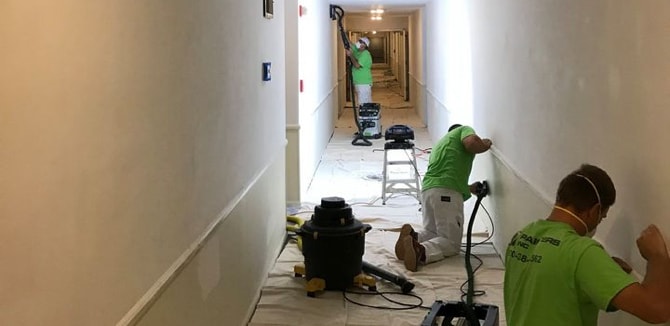
Acrylic latex paint comes out as one of the more flexible, versatile solutions for commercial painting projects where quality matters, as does durability and a long-lasting solution. From offering a non-toxic option to being a paint that will adhere to practically any surface, there are many reasons to choose acrylic latex paint for your project.
Choose latex paints for commercial interior projects
Commercial interior painting often employs latex paint of all finishes, as it is an affordable and widely available option, but is also extremely easy to clean thanks to its water-based composition. It’s also as easy to apply as it is to clean, which is a bonus to painting contractors responsible for covering thousands of square feet of surface area. Adding on to that list of positives is the fact that it is not going to emit the same level of fumes as other paints and is considered non-toxic. And finally, latex paint comes in so many colors and finishes that it will look great in just about any interior space.
Choose acrylic paints for commercial exterior projects
Commercial exterior painting often involves the use of acrylic paint due to its ability to hold up to harsh conditions and provide long-lasting durability that is so important. The best exterior acrylic paint not only holds up well in just about any situation, but it also looks great – maintaining its color for years and years. From office buildings to warehouses, commercial projects utilizing acrylic paint come in with impressive results that validate a painting contractor’s decision to use this product. When durability, performance and aesthetics are important in equal measure, acrylic paint becomes the top contender.
Choose acrylic latex paint for both interior and exterior projects
Acrylic latex paint comes in as a great choice for interior and exterior work, as this flexible product offers a full list of advantages. For example, acrylic latex interior paint brings all the advantages of acrylic, such as great coverage and durability, but is also as easy to clean up as latex paint. Commercial interior and exterior painting professionals rely heavily on acrylic latex exterior paint as much as they do on interior paint. From offering amazing results on everything from stone facades to concrete foundations, interior drywall to wood surfaces, there are plenty of reasons to make this your paint of choice.
The best painting outcomes are those that involve a trusted, experienced and quality painting contractor that prioritizes your needs. Seasoned contractors can help you make the right decisions about which paints will work in specific areas of your commercial property. At VIS Exterior, we partner with our clients to help them with painting projects, whether they’re interior, exterior or both. We assist in everything from finding the right colors, the right finishes and the right type of paint. Contact us and let’s discuss how we can transform your spaces.
The best quality paint brands for interior and exterior painting projects
The best painting contractors earn their reputations through choosing the best quality paint brands and applying them with expertise. Relying on some of the top performing paints provides the kind of durability and aesthetic qualities that enhance projects, and to that end, painting contractors will regularly choose products from Sherwin-Williams and Benjamin Moore, as these are the two “heavy weights” that all painting contractors can rely on.
Each of these paint companies provides a long list of colors and finishes in acrylic, latex and acrylic latex paint. The best quality exterior paint and the best quality interior paint can be found in the paint catalogs from Sherwin-Williams and Benjamin Moore.


Best Sherwin-Williams acrylic and latex paints
The best Sherwin-Williams paints are offered in acrylic and latex products, as well as Sherwin-William acrylic latex paint products. For exterior projects, popular options include Sherwin-William acrylic paints. For interior projects, one of the go-to choices is the Sherwin-Williams latex paint. Given the history of this company and the millions of gallons of quality paint it has sold and the rave reviews it receives, there is no going wrong with this brand.
Sherwin-Williams interior paints
Sherwin-Williams interior paints are a highly-prized product that all quality painting contractors hold dear. When impressing clients with rich, stunning and long-lasting paint is the goal, this company doesn’t disappoint.
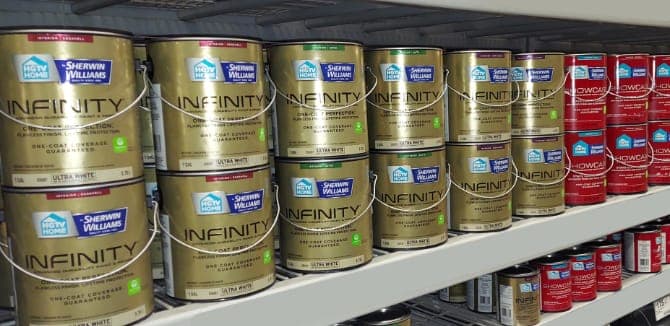
At VIS Exterior, we’ve worked with so many different brands that we know what works, and Sherwin-Williams provides a wide selection of interior paints that we can count on. This brand has even developed a patented “Air Purifying Technology” that not only brings a non-toxic solution to the table, but it actually helps to clean the air.
Emerald Interior Acrylic Latex Paint
Looking for a washable, flexible and high-quality paint? Sherwin-Williams’ acrylic latex paint offers that, but it also provides excellent coverage. This paint is also resistant to water streaks and prevents stains from compromising the integrity of your painted surfaces. Emerald also excels at preventing mold and mildew growth, as it includes antimicrobial ingredients.
SuperPaint Interior Acrylic Latex
Another acrylic latex product from Sherwin-Williams offers a paint and primer in one. SuperPaint Interior offers the kind of long-lasting finish that painting contractors treasure, but it’s also capable of hiding colors from older paints for that smooth appearance. It’s also highly durable and capable of withstanding frequent scrubbing, which makes it a great choice for high-traffic interior spaces.
Duration Home Interior Acrylic Latex
Looking for great coverage in fewer coats? Duration Home Interior is the primer and paint in one that offers that as well as the antimicrobial properties that keep mold and mildew from growing on your surfaces. The stain-blocking technology allows this paint to endure some fairly tough environments. However, when the surfaces do encounter dirt and grime, it can be easily managed with the wipe of a cloth.
Cashmere Interior Acrylic Latex
Silky and rich, the finish on this apt-titled paint is the envy of everyone. Cashmere Interior brings luxury, but it’s also easy to apply and dries with a super-smooth finish. For those in need of an interior paint that offers the paint and primer in one, is easy to clean and will look amazing for many years, this is your paint.
Emerald Designer Edition Interior Latex Paint
Taking a step in the designer direction, Emerald Designer Edition latex paint offers that little extra bit of luxury for a smooth finish that is uniform, providing that flawless finish, but it’s also capable of hiding previous paints colors. For those with discerning tastes, you’ll be happy to know this one comes in no fewer than 200 colors.
SuperPaint Interior Acrylic with Air Purifying Technology
Who doesn’t want a cleaner environment? Rather than having to worry about paint that is going to emit foul odors for days and days, SuperPaint Interior Acrylic paint from Sherwin-Williams offers air purifying technology, which is a formula that brings zero VOCs to your interiors, but also works to clean the air. Basically, the technology transforms airborne VOCs into water molecules and harmless, inert gas.
Sherwin-Williams exterior paints
Exterior paints need to be manufactured in a way that provides the kind of durability that holds up to tough weather and that’s exactly what the engineers at Sherwin-Williams have done. Contractors know that when they choose Sherwin-Williams exterior paints, they’re in good hands, as are the customers.

But durability isn’t everything – the company also makes a product that looks amazing on exterior surfaces. The colors pop with vibrancy and the various finishes provide exactly what those with exacting tastes desire.
SuperPaint Exterior Acrylic Latex
When you have SuperPaint® Exterior Acrylic Latex applied to your exterior surfaces, you get a paint that performs well against whatever Mother Nature has to offer. From the heat and humidity of summer to the frosty cold of winter, this paint endures with its advanced acrylic resin technology. When color retention and resistance against mold and mildew are also important, count on SuperPaint.
Duration Exterior Acrylic Latex
Formulated with PermaLast technology, Duration Premium Exterior acrylic latex paint is built to handle the rigors that exterior surfaces are subjected to. This product is infused with advanced acrylic copolymers, which offer excellent performance. That performance extends to its application, as this self-priming product only takes a single coat for a repainting project.
Emerald Exterior Acrylic Latex Paint
Using a primer and paint product like Emerald Exterior premium paint brings that ease-of-use element to the forefront, but it also is known for its stunning looks on exterior surfaces. When you want to cut down on the labor in your project and get attractive results, Emerald is the paint for you.
Resilience Exterior Acrylic Latex
Resilience Exterior is well known among professional painters as a product that offers a high-quality exterior finish, due in part to its built-in MoistureGuard Technology, which offers top-notch moisture resistance. Expertly applied and dried, this paint offers resistance to early dirt pick up, which is why it is recommended for use on aluminum and vinyl siding, but also works well with everything from wood siding to masonry.
Latitude Exterior Acrylic Latex
For exteriors exposed to a great amount of moisture, having moisture-resistant latex paint at your service offers extreme protection. That’s what Latitude Exterior is built to do – prevent moisture-related damage and protect against extreme temperatures. The built-in ClimateFlex Technology offers the type of moisture resistance that contractors rely on to keep their customers happy.
Emerald Rain Refresh Exterior Acrylic Latex Paint
With the Self-Cleaning Technology that comes with Emerald Rain Refresh paint, users get the ultra-durable protection they’re looking for, but also the ability to wash dirt away upon contact with moisture. When frequent maintenance is not an option, let the paint do the work for you. The product is also built with UV protection to keep the colors fresh even after years of sunlight exposure.
Best Benjamin Moore acrylic and latex paints
Benjamin Moore stands out as a paint manufacturer that has made a huge difference in the market. Some of the best Benjamin Moore paints are acrylic latex paints. The company has a rich history of producing quality products that are reliable from one paint type to the next. When the discussion turns to companies that have established a benchmark, Benjamin Moore latex paint and Benjamin Moore acrylic paint are certainly among the first to be mentioned.
Benjamin Moore interior paints
Painting contractors know where to turn when a job calls for quality products. Benjamin Moore interior paints definitely fit that bill, as the brand is known for its commitment to quality.
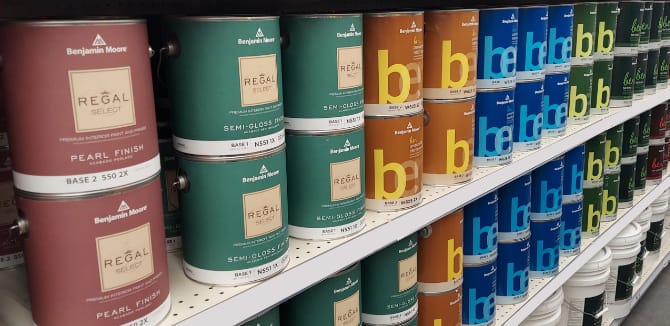
When a customer wants to elevate their interior spaces, they know they can count on the rich colors and stylish finishes offered by this company, whether it’s a latex or an acrylic latex product. Constantly developing new technologies that bring value to customers, Benjamin Moore’s interior paint offerings don’t disappoint and include the following.
Eco Spec™ acrylic latex paint
When a customer is environmentally conscious, they want Eco Spec acrylic latex paint, as this product utilizes pigments that are VOC free. Its popularity for interior projects is in part due to the fact that there are no harmful chemical emissions to worry about breathing in. But another reason is that this paint is available in no less than 3,000 colors. Another perk of using this paint is that you get a smooth finish.
Aura® acrylic interior paint
Rich yet durable finishes are what you get with Aura acrylic interior paint, which is considered one of Benjamin Moore’s “top of the line” products for interiors. Why? Because this paint contains more pigments than others, bringing out some of the richest colors possible. It’s made with an acrylic resin formula that dries really fast, yet it leaves a smooth finish that satisfies every single time.
ben® acrylic latex paint
The name keeps it understated with a lowercase b, but ben acrylic paint is anything but simple. This product offers an easy application and touch up process, but it is scuff resistant, low odor and can handle an extensive open time without drying out. ben has zero VOCs, so you know you’re working with safe paint, but it looks great and lasts a long time.
REGAL™ Select Acrylic interior paint
When you need a premium-quality paint that is splatter resistant and offers seamless touch ups, you’re going to want to choose REGAL Select. It dries fast, which means projects can be completed sooner, but is also durable. You can count on it in high-traffic areas, as it will withstand the usual wear and tear like no other paint.
Benjamin Moore exterior paints
Few brands can boast the durability that Benjamin Moore exterior paints offer. The company has focused on assisting customers in elevating their exterior spaces with an aesthetic touch that only premium brands such as Benjamin Moore can offer.
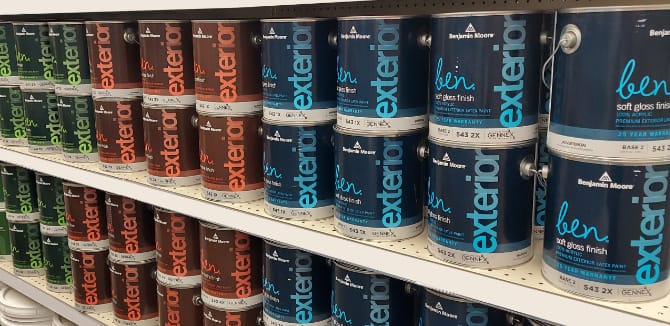
Vibrant, rich colors are also part of the deal with this brand’s exterior paints. Cutting-edge paint technology helps to make these paints adherable to just about any surface, yet resist cracking and peeling. The following are some of the most talked about exterior paints in this brand’s catalog.
AURA® exterior acrylic paint
Aura is made with Benjamin Moore’s patented Color Lock technology, which offers a richness in color that is unparalleled, but also makes the paint super durable. The colors in this paint, of which there are plenty to choose, are resistant to fading. Furthermore, you won’t have to worry about this paint chalking as it ages, as Aura exterior acrylic paint also resists that common problem.
Coronado® Cryli Cote® 100% acrylic exterior paint
Value and durability? Yes, Benjamin Moore offers both with Coronado Cryli Cote, which offers adhesion qualities that every painting contractor relies on, but without gouging the wallet. This self-priming paint offers great coverage on most surfaces and is also fast to dry for quicker project completion. The cherry on top is that it is also mildew resistant.
REGAL® SELECT exterior high-build acrylic latex paint
Applying thick coats of paint usually results in sagging, but REGAL SELECT is formulated to go on super thick without all the side effects. This means you can bridge small gaps without having to worry about cracks and sags. From wood to vinyl to masonry and fiber cement board, this product works well on many siding types and will protect surfaces from harsh weather.
Ultra Spec® EXT acrylic paint
No matter what color you choose with Ultra Spec EXT, you get low VOCs in return. And despite the lack of chemicals, it still resists color fading and blistering. The durability of this paint, as well as its rapid drying qualities, make it a go-to choice for painting contractors, but property managers and facility managers are also big users of this product.
There are many exterior paints on the market today, but when Benjamin Moore is on your brush, you can count on quality every time. “Curb appeal that lasts” isn’t the company motto, but it could be.
Hire a professional painting contractor in the Chicago area
When you partner with a painting contractor that cares about their reputation, it shows in every job they do. From the way they communicate with a client or potential client to the products they use to the way they handle themselves on the jobsite, quality contractors take every aspect of the job seriously. That’s what we do at VIS Exterior. We live and work among the very people we paint for and we take pride in the work we do.

Need to hear about our services from someone you can trust? Ask any of our former customers and they’ll tell you about the return on investment. We’re licensed, insured, certified and we offer a warranty on our work. Contact us and let’s discuss your painting project and how we can be of value to you.









